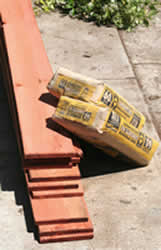Planning a Wooden Fence
As with all home improvement projects,
planning is the first step in building a fence. To plan properly, it
is important to consider many things. What is the purpose of the fence?
Are you trying to create a private area, keep pets in your yard, or is
it for aesthetic purposes? If you are fencing a swimming pool,
what is the minimum height required by local code? Are there trees
or other plantings that you wish to preserve or draw attention to with
the fence? If there are to be gates, where will they be placed? Plan
the gates large enough to accommodate anything that must pass through
them. If you are placing a fence on a property boundary, you must know
the location of the property line. Underground utilities may also dictate
where your fence can be placed. Finally, what style of fence do you want?
 |
If your fence is to separate your yard from a neighbor’s, it is
best to discuss it with them. You will need at least some access to
their yard during construction,
and they may have concerns that need
to be addressed. If you have chosen a style that has only one good side,
you may want to alternate the fence panel sections so that you and your
neighbor each get a fair share of the more attractive fence.
It is often possible to share the cost of building a fence with your neighbor.
If this is the case, it is best to involve them in the planning as much
as possible. Each agreement varies, sometimes with one neighbor supplying
the materials and the other supplying the labor and other times with each
neighbor supplying a portion of both. To keep things clear and avoid future
disputes, it is best to have any agreement in writing.
A fence between neighbors who are in agreement is often placed directly
on the property line. It is recommended that you avoid this because neighbors
move over time and it could leave you, or a new homeowner, open to a potential
dispute. A fence built six inches to one foot, depending on local code,
inside your property will avoid future disputes.
Once you have decided on the placement of your fence, it is time to begin
measuring. It is best to place stakes where you plan the corners of your
fence, and mark any changes in the fence line. Once the stakes are placed,
you simply measure the distance between them. This is best achieved by using
a long, flexible tape measure like the type favored by landscapers or a
measuring wheel, although a shorter tape measure can be used and the results
added together. These results will allow you to calculate the amount of
materials needed for the fence.
Slopes on the property should be considered and incorporated into the
design of any fence. No matter how drastic the slope, your posts should
remain upright as determined by a level or plumb-bob. This makes it necessary
to step the fence either in sections between posts, or board by board.
If you choose to step the fence in sections, it is best to keep both the
length of the sections and the height of the steps fairly close. While a
few inches doesn’t matter, drastic differences will give an unbalanced
appearance. If you are stepping a fence in sections, it is important to
measure the distance then work out how many equal sections will be necessary.
The length and slope of your lot may dictate that six foot sections be used
instead of eight foot sections, for instance.
If you choose to step the fence board by board, you will need to take
into account the need for longer stringers and be prepared to cut the stringers
on an angle. Stepping a fence board by board will help to disguise uneven
section sizes.
The material you choose for your fence is important. It will dictate the
longevity of your fence, as well as the appearance and required upkeep.
Redwood and cedar are naturally resistant to rot and insect damage, but
are expensive. Pressure treated lumber costs less and lasts longer under
most conditions, but raises some environmental questions that have not been
fully answered. Untreated softwoods such as pine are the least expensive,
but are prone to rot and insect damage.
If you are on a tight budget, pressure treated posts can be used in conjunction
with untreated softwood boards, but untreated pine must be painted or stained
to keep it from rotting. Even with painting or staining, the board will
rot around nails and screws and is not resistant to insects like termites.
It is recommended that you use a pressure treated product or a naturally
rot-resistant material such as cedar or redwood if at all possible.
Which materials you choose to work with will depend on how long you expect
the fence to last, your personal preferences, the choices others in your
neighborhood have made, and your lifestyle.
When you have finished your planning, it is time to get a building permit.
Local code requirements vary widely, with some places requiring no permits
and others having strict requirements. Check with your local city or
county planning office to learn exactly what you need. In most cases, a
plan noting height, length, placement, and materials is sufficient.
With your planning done and the permits in place, you are ready to start
building. |

